
Principles of Project Planning are essential for the successful execution of any project. A project is a carefully structured set of interrelated activities designed to achieve specific objectives within a defined timeframe and budget. The concept of project planning involves systematically coordinating resources, activities, and stakeholders to ensure the desired outcomes are achieved. By incorporating structured methodologies, such as logical frameworks and stakeholder analyses, project planning provides the foundation for efficient implementation, effective monitoring, and comprehensive evaluation. These principles help organizations address challenges, maximize benefits, and ensure sustainability in achieving their goals.
What is a project ?
There various definitions of project Principles of Project Planning.
Project can be defined as a set of planned, inter-related activities designed to achieve objectives within a given budget and a specified time.
An undertaking for the purpose of achieving established objectives, within a given budget and time period.
-
Geographical location
-
Target group
-
objectives
-
Activities ⇒ Outputs
-
Duration
-
Budget(Input)
The concepts of project planning in Principles of Project Planning.
A project is a set of planned investment activities where financial resources are allocated in order to create capital assets, which in turn produce benefits over an extended period of time.or A project is a set of planned activities through which resources are allocated within a specific timeframe, with the expectation that they will yield future returns.or A project is intended to accomplish specific objectives at specific time period.
Project in Principles of Project Planning should be comprised of:
-
A set of unique time-bound series of activities, but not an endless series of activities,
-
Have specific geographical location or a clearly understood geographical areas of concentration,
-
Specific clientele, beneficiaries or target group which the project intends to reach/impact.
-
Wholly or partially independent administrative structure.
-
A set of accounts and be funded through a specifically defined financial package.
-
The activities of project are coordinated by project manager
-
Project management is the discipline of initiating, planning, executing, controlling and closing the work of a team to achieve specific goals and meet specific success criteria.
The concept of project planning in Principles of Project Planning.
- Policy is a course of action that provides guidelines for present and future decision-making, therefore ensuring consistency and direction in organizational practices.
- Policies set the framework within which both programs and projects are designed and executed, therefore guiding the overall direction and ensuring alignment with organizational goals
- The formulation of suitable and appropriate policies is crucial because it serves as a prerequisite for the successful execution of programs and projects.
- Plans refers to specific quantitative economic targets which have to be achieved within specified period of time in a society.
- Program-Series of projects whose objectives contribute to overall objective, at various levels of organization
- Programs are the broad areas of work required to fulfil specific policy goals
- To implement programs; break them down into groups of related smaller manageable units which are called projects
- What is a strategy – Identifies the organizational goals and identify the ways of achieving those goals . Project can be one of those goals.
- A project plan is a series of formal documents that define the execution and control stages of a project.
- The plan includes considerations for risk management, resource management and communications, while also addressing scope, cost and schedule baselines.
- Tasks: Small jobs that lead to the final deliverable.
- Deliverables this is the results of a project, such as a product, service, or report
- Resources: Anything you need to complete the project, such as personnel, supplies, materials, tools, people and more.
- Budget: Estimate of total cost related to completing a project.
- Tracking & Monitoring: Collecting project data, and making sure it reflects the results you planned for
- logical frame aproach (LFA )-
Is a methodology for planning managing and evaluating programmes and projects, using tools to enhance participation and transparency and to improve orientation towards objectives.
Project stakeholder in Principles of Project Planning.
-
Stakeholders are individuals and organizations who are actively involved in the project, or whose interests may be affected either by the implementation or by the completion of the project.
-
Stakeholders may also exert influence over a project’s objectives and outcomes, either positively or negatively,depending on their interests and level of involvement
-
They have both positive and negative influences on the project.
-
The project management team must identify the stakeholders, and then determine their requirements as well asexpectations.
Project stakeholder in Principles of Project Planning.
There are two types of stakeholders
-
Primary stakeholders and secondary stakeholders.
-
Failure to identify key stakeholders can cause harm to the project.
-
Project monitoring is the regular, systematic, and purposeful observation and recording of activities taking place in the project. In other words, it is the way the project is measured, managed, and kept on track according to the plans.
-
Monitoring involves the collection, analysis, communication, and use of information about the project’s progress, thereby ensuring that the project stays on track and meets its objectives.
-
The objective of project monitoring is to highlight strengths and weaknesses in project implementation, therefore allowing for timely adjustments to ensure the project stays on track.
What is a project review in Principles of Project Planning?
- A project review, therefore, helps to further the analysis of the information collected, allowing for a deeper understanding and providing insights that guide future decisions.
- The main purpose of the review is to reflect on project progress, as well as share information and ideas, therefore re-build project teams, make collective decisions over the identified problems, and re-plan the project activities as appropriate.
- Regular reviews may be conducted at different levels within the project management structure, and they help ensure ongoing alignment with project goals. Additionally, these reviews provide valuable insights into project progress, whichcan lead to timely adjustments and improvements.
- Regular reviews involve individuals who have been directly engaged in project implementation for at least six months.
PROJECT EVALUATION in Principles of Project Planning.
-
Project evaluation is a systematic, investigative collection of information that helps determine whether the project is proceeding as planned. In addition, it provides valuable insights into the project’s progress and effectiveness.
-
Whether it is meeting its stated goals and project objectives within the proposed timeline, or if adjustments are necessary to stay on track.
-
During evaluation, data are examined to assess whether the current operation is satisfactory, or alternatively, if some modifications might be needed.
-
At the planning stage, we have identified the output, outcome, and impact that the project is expected to achieve or contribute to. Therefore, this forms the basis for the evaluation process.
The evaluation process is comparative in nature.
-
Evaluation generally begins at the start of the project with the collection of baseline information; subsequently, we can collect follow-up information and compare it with the baseline to assess how much things have changed.
-
Evaluation is supposed to be an integral part of the project cycle management process, as it helps assess progress and outcomes, ensuring that the project stays aligned with its goals and objectives.
What is Project Cycle in Principles of Project Planning?
-
The sequence in which projects are planned and carried.
-
The way in wich projects are planned and carried, determine the failure or
-
PCM-Defines different phases in the project life with well-defined management activities and decision making procedures
What is Project Cycle in Principles of Project Planning?
-
Programming;
-
Project identification
-
Project formulation
-
Project Financing
-
Implementation
-
Monitoring
-
Evaluation
The generic project cycle has six phases: Programming;Identification; Formulation; Financing; Implementation; and Evaluation.
The details of what occurs during each phase differ between institutions, reflecting differences in procedures.
Other organization can group the phases into 5 major stages
identification, preparation, appraisal, implementation and evaluation.
However, within all institutions the cycle shares three common themes:
-
The cycle defines the key decisions, information requirements, and responsibilities at each phase, thus ensuring clarity and structure throughout the project. Moreover, it helps guide the project team by outlining essential actions and responsibilities for each stage
-
The phases in the cycle are progressive, as each phase must be completed before the next can be tackled successfully.
-
The cycle draws on evaluation as a means to build experience from existing projects, thereby contributing to the design of future programs and projects.
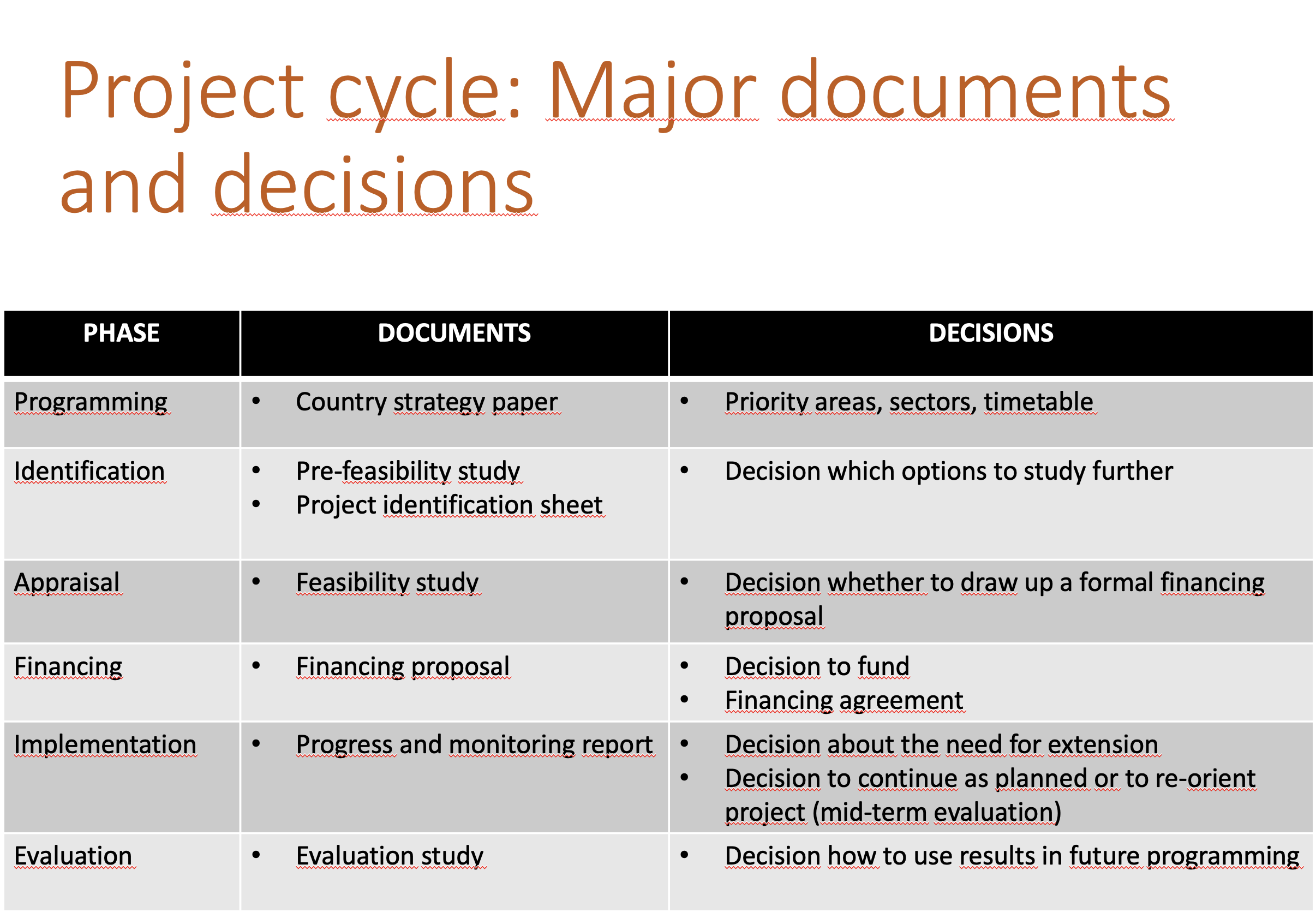
The basic format or structure of project and programme documents in Principles of Project Planning.
-
Summary
-
Background
-
Sectoral and problem analysis
-
Project/programme description
-
Assumption risks
-
Implementation arrangement (Work plan, Costs and financing plan, etc.)
-
Quality factors ( Policies, socio-cultural aspects, financial viability, technology, etc.)
-
Annex (Logframe, and other extra information)
Programming Stage in Principles of Project Planning.
During the Programming phase, the situation at the national and sector level is analyzed to identify problems, constraints, and opportunities that the project could address. This process involves a review of socio-economic indicators, as well asnational and donor priorities.
Key Activities of Programming in Principles of Project Planning.
-
Review of Socio- Economic indicator.
-
Review of partners and donor priorities.
-
Agreement of sectoral and thematic focus for co-operation through an agreed strategy formulation.
Principles of programming in Principles of Project Planning
-
Poverty focus
-
Policy mix:
-
Country ownership
-
Work sharing and complementarity
-
Comprehensive country analysis
-
Concentration of efforts on a limited number of areas
-
Cross-cutting and overarching policy issues
-
Other key aspects of development policy:
-
Feedback: Lessons of past experience
-
Open partnership:
Identification stage in Principles of Project Planning.
During the Identification phase, ideas for projects and other development actions are identified and subsequently screened for further study.
This involves consultation with the intended beneficiaries of each action, followed by an analysis of the problems they face, and subsequently, the identification of options to address these problems.
A decision can then be made on the relevance of each project idea (both to the intended beneficiaries and to the programming framework), and consequently, on which ideas should be further studied during the Formulation phase.
Expected outcomes of identification.
-
A pre-feasibility study, which analyzes a given situation, serves as the foundation for determining the viability of a project before further development.
-
A Project Identification Sheet, which outlines the key aspects of the project, serves as the foundation for further analysis and decision-making, helping to ensure the project’s relevance and feasibility.
What is a Project Feasibility Study?
The project feasibility study is a document that contains a detailed description of the project, followed by a set of different feasibility areas to assess its viability and potential for success.
These are aspects of the project that will drive its success or failure. Therefore, this study will provide the necessary information so that you can decide whether or not your project should begin, and whether it has a chance of success.
Purpose of identification phase in Principles of Project Planning.
-
The analysis of the problems that beneficiaries face is conducted in order to identify options that can address these problems effectively.
-
Identify project ideas that are consistent with the project goals, and ensure they align with the overall objectives.
-
First, assess the relevance of these project ideas, and then evaluate their feasibility to determine whether they can be successfully implemented.
Project identification criteria in Principles of Project Planning.
- Are the major stakeholders of the project clearly identified and described?
- Are the beneficiaries clearly identified?
- Are the problems of beneficiaries sufficiently described?
- Is the problem analysis sufficiently comprehensive?
- Do the outlined Overall Objectives explain why the project is important for sectoral development and society?
- Does the project purpose express a direct benefit for target groups, and if so, how effectively does it align with their specific needs and objectives?
Feasible – The project is well designed and is likely to deliver tangible and sustainable benefits to target groups.
-
Will the Project Purpose contribute to the Overall Objectives?
-
Are Results products of the implementation of Activities?
-
Will the Project Purpose be achieved if the Results are attained?
-
Can the Results and Purposes realistically be achieved with the Means suggested (first estimate)?
-
Have important external factors been identified (socio-political)?
-
Is the probability of realization of the assumptions acceptable (out of your control)?
-
Will the suggested project partners and implementing agencies be able to implement the project?
Project identification stages in Principles of Project Planning.
Identification involves, the following sequence
- Preliminary stakeholder analysis
- Problem analysis
- Setting of objectives
- Analysis of alternatives
- Accountability analysis
- Logical framework thinking
- Analysis of assumptions and associated risks
- Progress indicator definition
- Stakeholder review
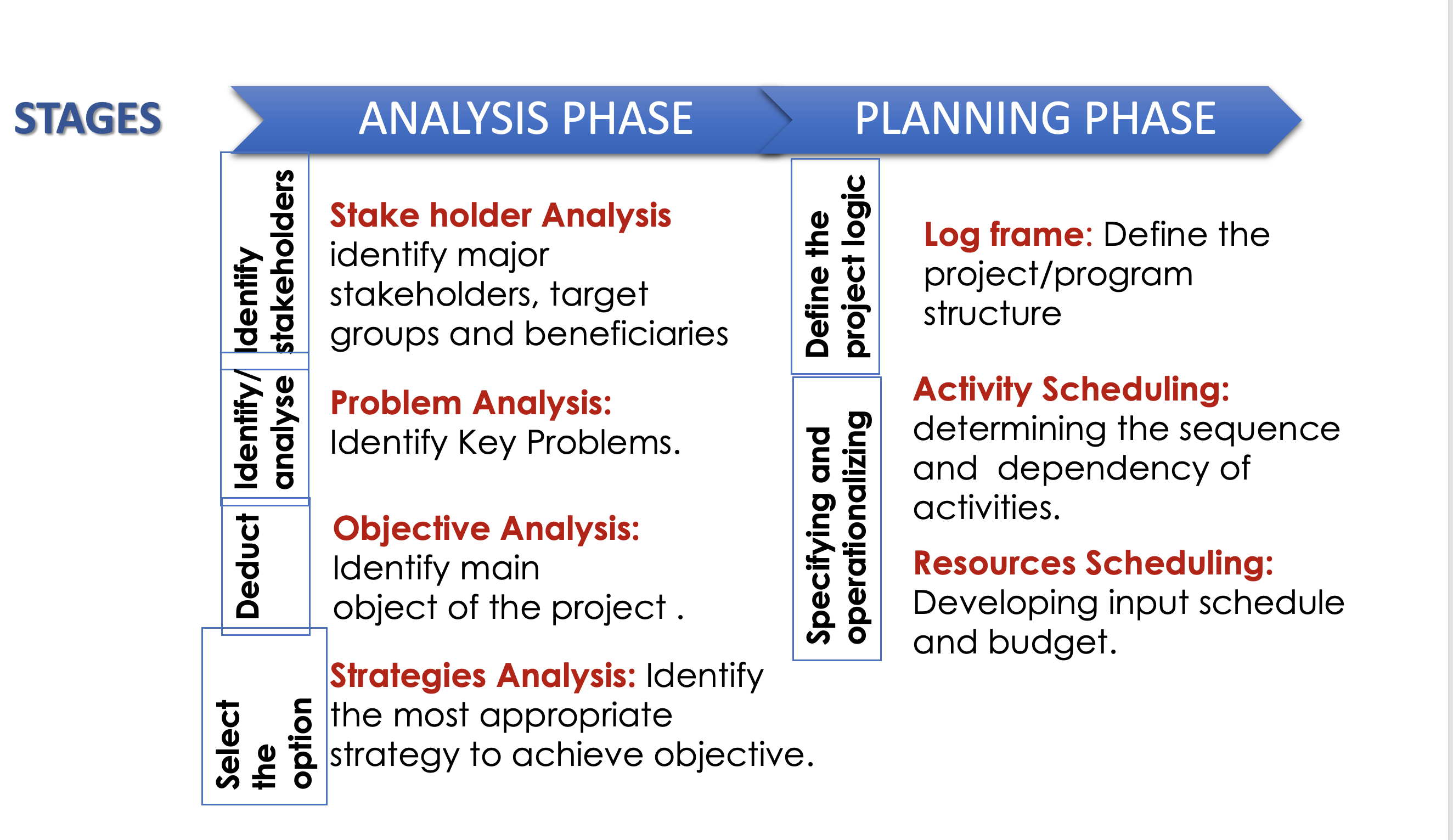
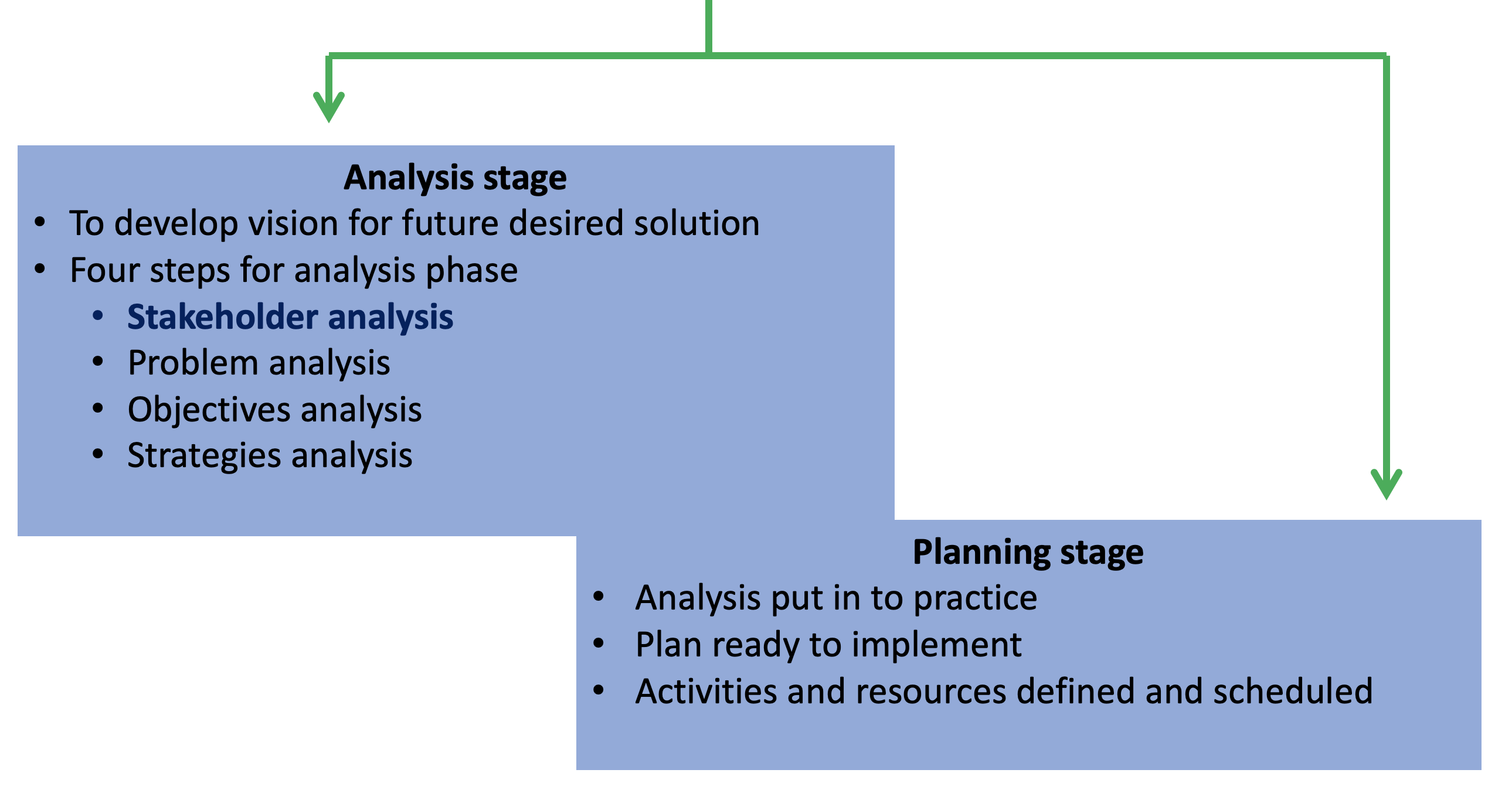
STEP1 Stakeholders Analysis in Principles of Project Planning.
Focus on people and organization.
Tentatively select a target group in Stakeholders Analysis.
Stakeholders are all individuals or entities who should or can influence the implementation or success of a project, as well as those who should or can be influenced by the project’s implementation or results.
Any individuals, groups of people, institutions or firms that may have a relationship with the project. It can effect negatively or positively.
Why need stakeholder analysis?
-
- To maximize the social and institutional benefits
- To minimize its negative impacts
- It should be done in early stage of project( identification, appraisal)
- Gender issues can damage effectiveness and sustainability
- This analysis must systematically identify all gender differences, as well as the specific interests, problems and potentials of women and man among the stakeholder groups.
How to Proceed?
- Start with identifying the various stakeholders, in a gender-differentiated way,
- Who might be affected by the project;
- Who might affect the project;
- Who might become useful project partners even though the project may also be implemented without their contribution;
- Who might become conflict partners as they may face the project as a threat for their role and interests;
- Who will anyway be involved in the project.
Analysis of Stakeholders in Principles of Project Planning.
In analysis we focus on characteristics of
- Characteristics of key stakeholders, their interest and expectations,
- Their relation to the project and to cross-cutting issues
- Their capacities and drawbacks, and on their influence on the project.
- SWOT analysis or a description in a table, many other approaches can be used such as influence–interest–approach
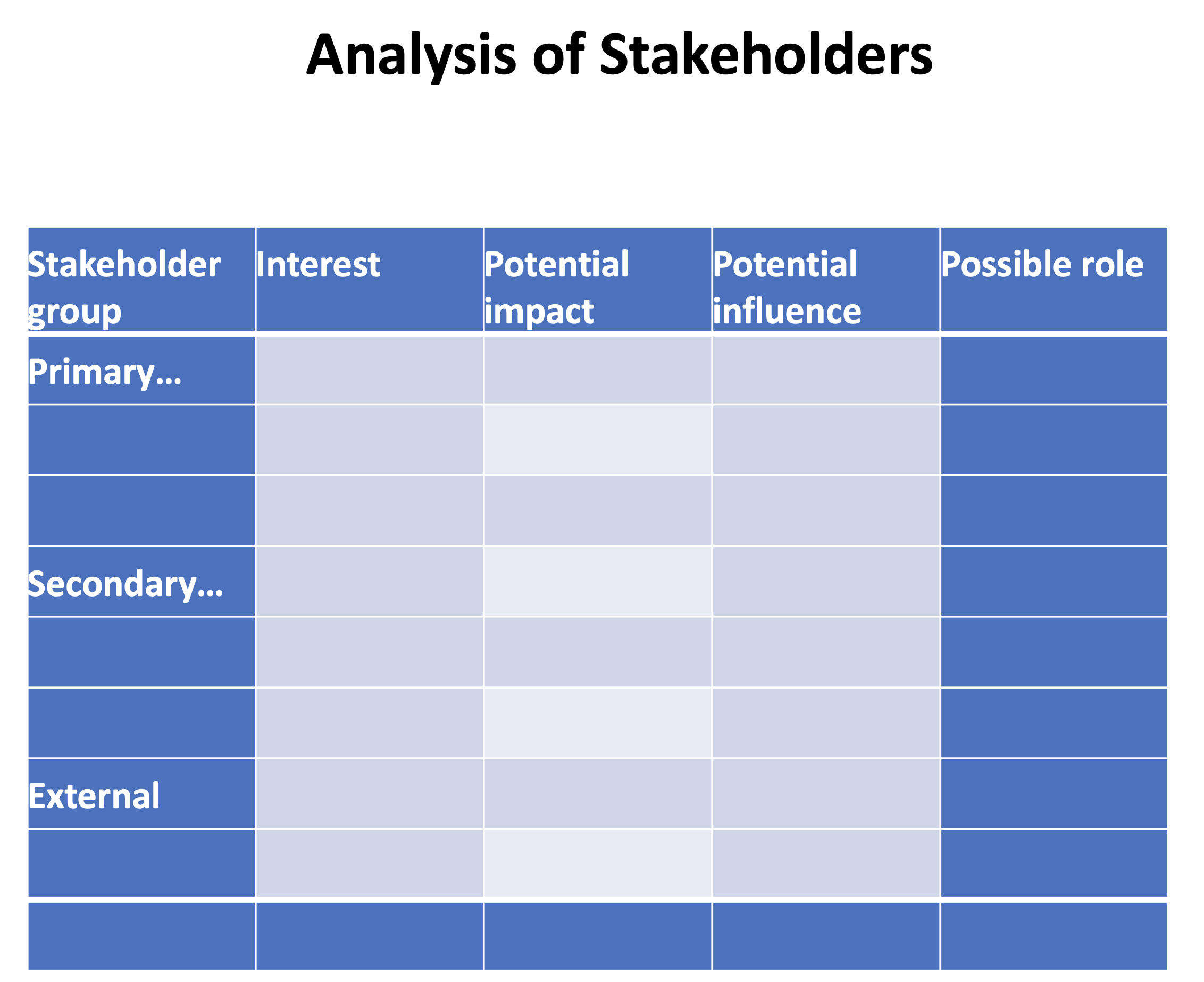
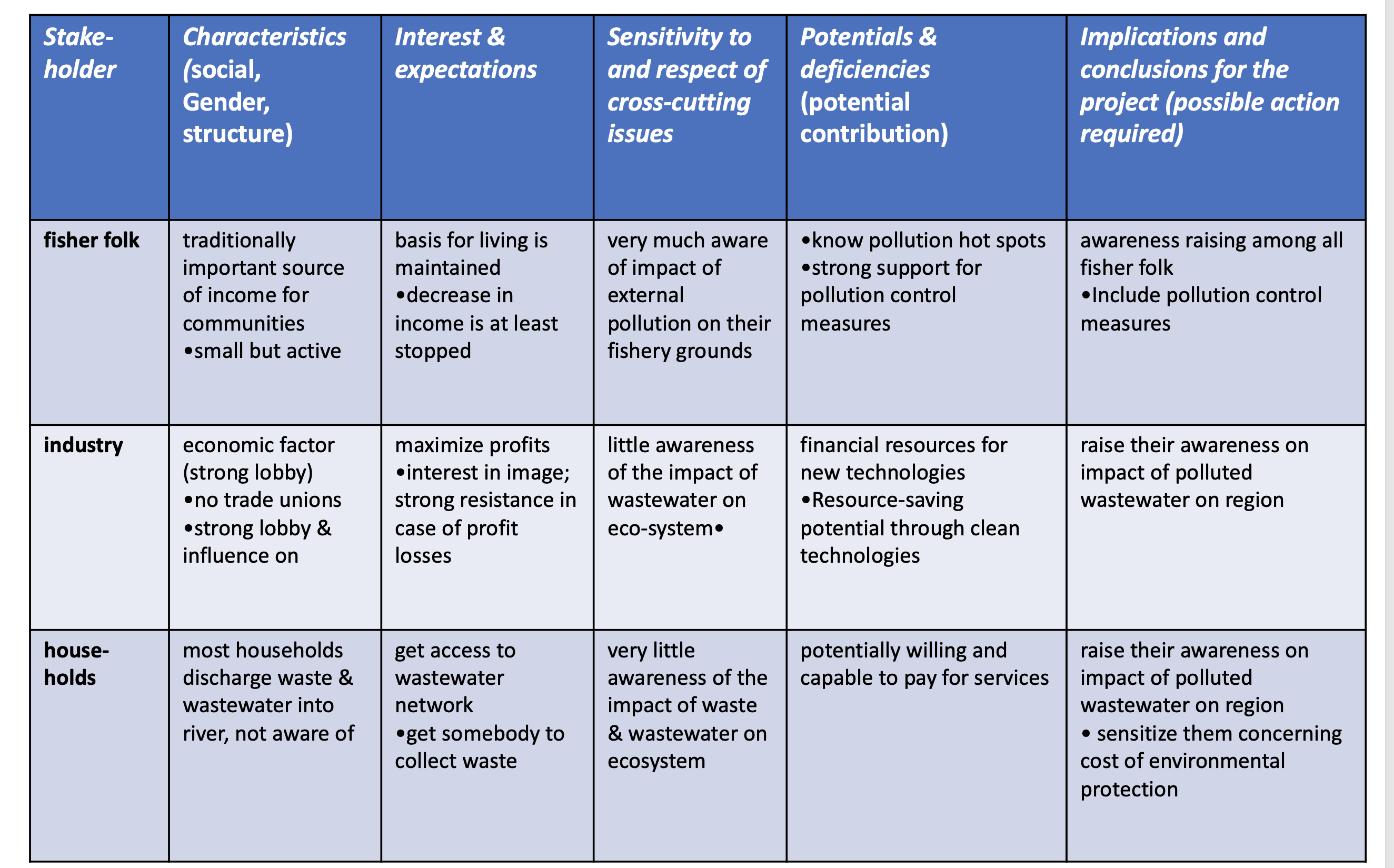
Limitation of Analysis of Stakeholders in Principles of Project Planning.
Stakeholder analysis is an effective and commonly used tool; however, its use does not guarantee success. Moreover, there are several risks and practical problems that should be avoided in its application, such as:
- the analysis can only be as good as the information collected and used
- use of matrices for analysis and presentation can oversimplify complex situations
- the judgements used in placing stakeholders in a matrix or table are often subjective.
- team working can be damaged if the differences between groups in an activity, rather than their common ground, are over-emphasised
- trying to describe winners and losers, as well as predicting hidden conflicts and interests, can alienate powerful groups
- the analysis may lead to the re-emergence of conflicts
STEP2 Problems Analysis.
Problem analysis visually represents the causes and effects of existing problems in the project area by using a Problem Tree, which helps clarify the relationships among the identified problems and provides a comprehensive understanding of their interconnected nature.
WHAT IS PROBLEM ANALYSIS?
It is a procedure which allows to:
- Analyse an existing situation;
- Identify key problems in this context (= negative existing situations);
- Establishing cause-effect relationships between problems in the tree/hierarchy .
HOW TO ESTABLISH PROBLEM TREE IN PROBLEM ANALYSIS?
STEPS IN PROBLEM ANALYSIS
- Identify major problems existing within a given situation(brainstorming).
- Select an individual starter problem.
- Look for related problems to the starter problem.
- Establish hierarchy of cause and effects. -causes are put below and effects are put above
- Complete with all other problems accordingly
- Connect the problems with cause-effect arrows
- Review the diagram and verify it’s validity and completeness.
NOTE
- Problems have to be worded as negative situations;
- Problems have to be existing problems, not future ones or margined ones;
- The position of the problem in the hierarchy does not indicate its importance;
- A problem is not the absence of a solution, but an existing negative situation.
- Once complete, the problem tree provides a comprehensive picture of the existing negative situation, thereby clarifying the cause-and-effect relationships, which in turn aids in identifying targeted solutions.
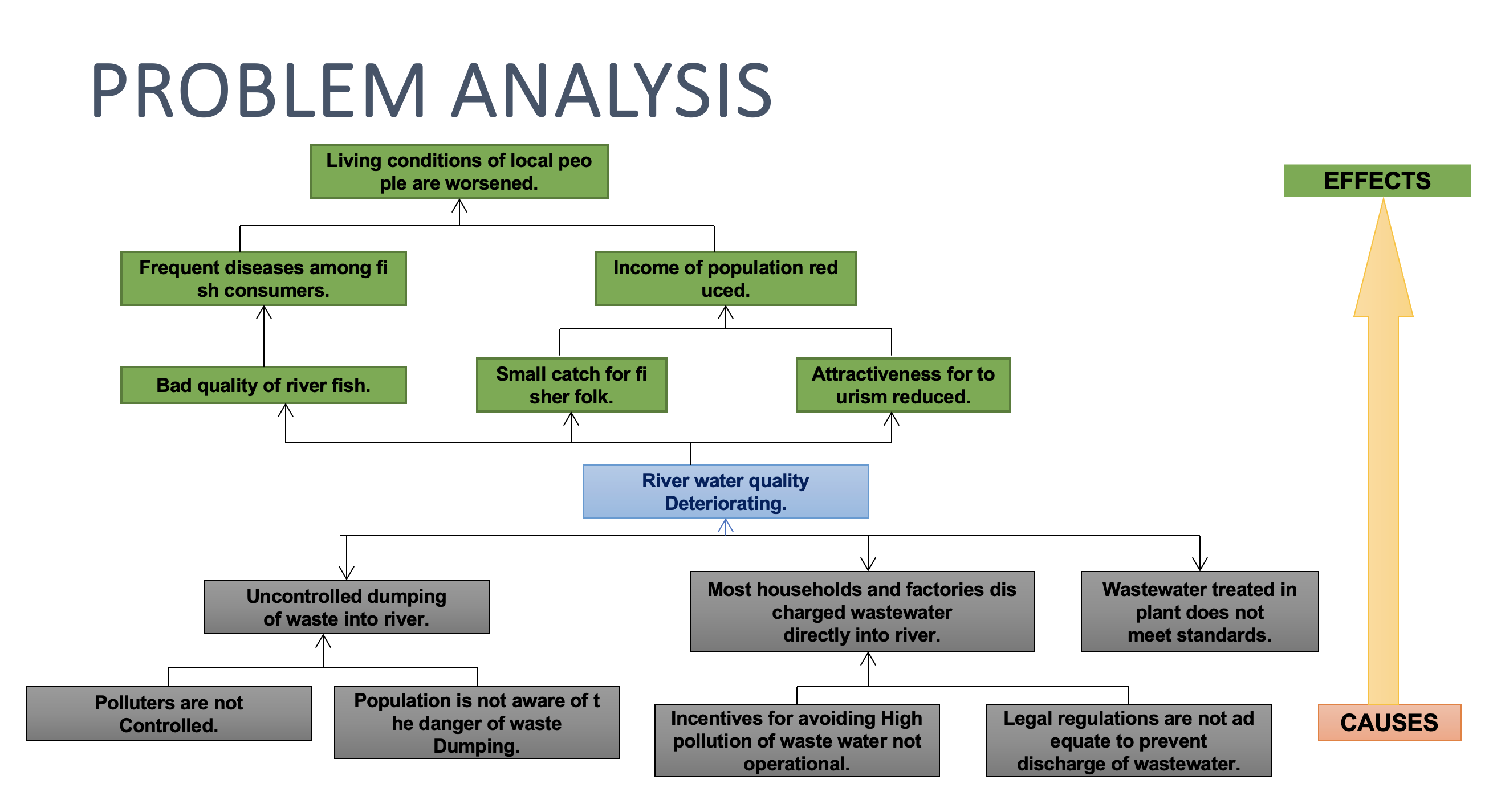
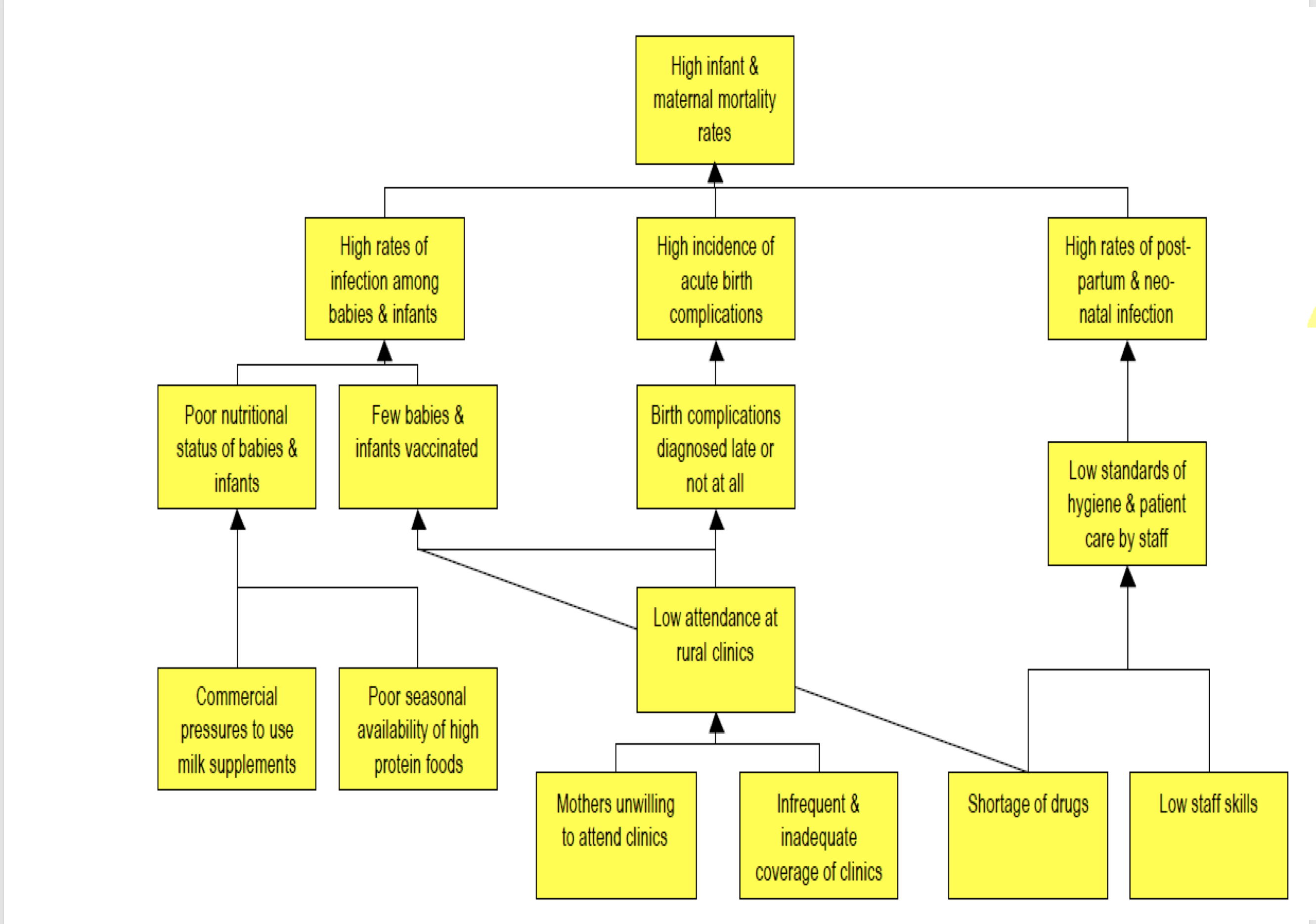
Difficulties in identifying Problems in Principles of Project Planning.
Statement of absent solutions -is not a problem
- Occurs when problem statement do not describe the current negative situation.
- But describe the absence of a desired situation
Example of problem.
- The lack of trained staff does not fully describe the specific problem; rather, it highlights that staff may have insufficient or inappropriate skills, which require further analysis to determine the root cause.
- This risks biasing the intervention towards the absent solution, such as training, even though the actual problem might lie in recruitment or personnel management.

Pingback: Risk and Projects - lecture theatre
Pingback: Critical Success Factors for Project Risk Management - lecture theatre
Pingback: Effective risk management - lecture theatre
Pingback: Dimensions Of Data Quality - lecture theatre
https://mazda-demio.ru/forums/index.php?autocom=gallery&req=si&img=6339
Good day, I am Troy Mefferd, a seasoned business consultant, specializes in providing funding solutions for both established business and nascent enterprises.
Should you be interested in obtaining financial support for your business. Please contact me at tryme@consultant.com
Troy Mefferd
Business Consulting Manager
Salut, ech wollt Äre Präis wëssen.